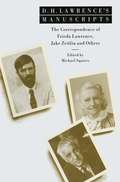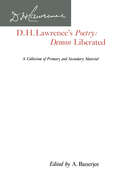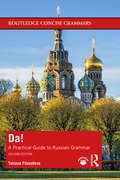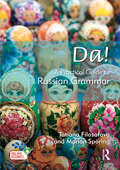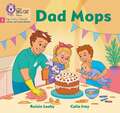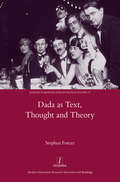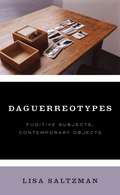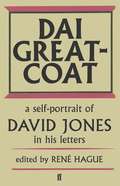- Table View
- List View
D.H. Lawrence, Travel and Cultural Difference
by N. RobertsThis study of Lawrence's travel writings is the first book-length study to approach the subject with reference to contemporary post-colonial theory. Focusing on the writings of 1921-25, the period when Lawrence was most intensely engaged in travel, it includes chapters on Sea and Sardinia, Kangaroo, The Plumed Serpent and the essays and stories inspired by Lawrence's experience of the New World.
D.H. Lawrence's Australia: Anxiety at the Edge of Empire
by David GameThe first full-length account of D.H. Lawrence’s rich engagement with a country he found both fascinating and frustrating, D.H. Lawrence’s Australia focuses on the philosophical, anthropological and literary influences that informed the utopian and regenerative visions that characterise so much of Lawrence’s work. David Game gives particular attention to the four novels and one novella published between 1920 and 1925, what Game calls Lawrence’s 'Australian period,' shedding new light on Lawrence’s attitudes towards Australia in general and, more specifically, towards Australian Aborigines, women and colonialism. He revisits key aspects of Lawrence’s development as a novelist and thinker, including the influence of Darwin and Lawrence’s rejection of eugenics, Christianity, psychoanalysis and science. While Game concentrates on the Australian novels such as Kangaroo and The Boy in the Bush, he also uncovers the Australian elements in a range of other works, including Lawrence’s last novel, Lady Chatterley’s Lover. Lawrence lived in Australia for just three months, but as Game shows, it played a significant role in his quest for a way of life that would enable regeneration of the individual in the face of what Lawrence saw as the moral collapse of modern industrial civilisation after the outbreak of World War I.
D.H. Lawrence's Australia: Anxiety at the Edge of Empire
by David GameThe first full-length account of D.H. Lawrence’s rich engagement with a country he found both fascinating and frustrating, D.H. Lawrence’s Australia focuses on the philosophical, anthropological and literary influences that informed the utopian and regenerative visions that characterise so much of Lawrence’s work. David Game gives particular attention to the four novels and one novella published between 1920 and 1925, what Game calls Lawrence’s 'Australian period,' shedding new light on Lawrence’s attitudes towards Australia in general and, more specifically, towards Australian Aborigines, women and colonialism. He revisits key aspects of Lawrence’s development as a novelist and thinker, including the influence of Darwin and Lawrence’s rejection of eugenics, Christianity, psychoanalysis and science. While Game concentrates on the Australian novels such as Kangaroo and The Boy in the Bush, he also uncovers the Australian elements in a range of other works, including Lawrence’s last novel, Lady Chatterley’s Lover. Lawrence lived in Australia for just three months, but as Game shows, it played a significant role in his quest for a way of life that would enable regeneration of the individual in the face of what Lawrence saw as the moral collapse of modern industrial civilisation after the outbreak of World War I.
D. H. Lawrence’s Language of Sacred Experience: The Transfiguration of the Reader
by C. BurackThis book demonstrates how D.H. Lawrence's prophetic ambitions impelled him to create novels that would radically transform the consciousness of his readers. Charles Burack argues that Lawrence's major novels, beginning with The Rainbow , are structured as religious initiation rites that attempt to break down the reader's normative mindset and to evoke new, numinous experiences of self and world. Through careful analysis of narrative structure, literary technique, and sacred discourses, Burack shows that Lawrence tries to initiate the reader into his own version of religious vitalism. Unlike most initiations that conclude with powerful affirmations, Lawrence's novels generally end with an attempt to subvert the formation of new religious dogmas and to encourage sacred-erotic exploration.
D. H. Lawrence’s Manuscripts: The Correspondence of Frieda Lawrence, Jake Zeitlin and Others (pdf)
by Michael SquiresD.H.Lawrence's Poetry: Demon Liberated
by Amitava BanerjeeThis book brings together articles and essays published over a period of about 60 years. These discussions lead to an assessment of Lawrence's poetry, showing how he has been regarded as a poet over the years, as well as analyzing the intrinsic merit of his poetry.
Da!: A Practical Guide to Russian Grammar (Routledge Concise Grammars)
by Tatiana FilosofovaThis fully revised second edition of Da! A Practical Guide to Russian Grammar is a concise and contemporary reference grammar and workbook for intermediate-level students. The book contains clear explanations of the core areas of Russian grammar. Each point is illustrated with examples of contemporary language usage showing you how grammar works in practice while at the same time enhancing your vocabulary and cultural knowledge. Every chapter ends with a variety of exercises to test your progress and consolidate your understanding. Now revised with more exercises and enhanced e-resources. Suitable for intermediate-level students, Da! A Practical Guide to Russian Grammar is an invaluable resource for both classroom and self-study.
Da! A Practical Guide to Russian Grammar
by Tatiana Filosofova Marion SporingDa! A Practical Guide to Russian Grammar is a concise and contemporary combined reference grammar and workbook for intermediate-level students, and is ideal for use both in the classroom and for self-study.The book contains clear explanations of the core areas of Russian grammar. Each point is illustrated with examples of contemporary language usage showing you how grammar works in practice while at the same time enhancing your vocabulary and cultural knowledge. Every chapter ends with a variety of exercises to test your progress and consolidate your understanding. Da! A Practical Guide to Russian Grammar features:Tables to help you absorb more easily specific rules of grammar.Level indicators so you can tailor learning to suit your ability and progress with confidence.In-text icons that identify difficult points of grammar for you so you know where you need to focus that little bit harderA glossary to aid your understanding of complex grammatical terms.Exercises at the ends of chapters so you can test your comprehensionAnswers to Exercises so you can check your own work.With free access to online, interactive exercises with audio that give you practice listening and pronouncing Russian, Da! A Practical Guide to Russian Grammar is one of the most comprehensive resources for Russian grammar available.
Da! A Practical Guide to Russian Grammar
by Tatiana Filosofova Marion SporingDa! A Practical Guide to Russian Grammar is a concise and contemporary combined reference grammar and workbook for intermediate-level students, and is ideal for use both in the classroom and for self-study.The book contains clear explanations of the core areas of Russian grammar. Each point is illustrated with examples of contemporary language usage showing you how grammar works in practice while at the same time enhancing your vocabulary and cultural knowledge. Every chapter ends with a variety of exercises to test your progress and consolidate your understanding. Da! A Practical Guide to Russian Grammar features:Tables to help you absorb more easily specific rules of grammar.Level indicators so you can tailor learning to suit your ability and progress with confidence.In-text icons that identify difficult points of grammar for you so you know where you need to focus that little bit harderA glossary to aid your understanding of complex grammatical terms.Exercises at the ends of chapters so you can test your comprehensionAnswers to Exercises so you can check your own work.With free access to online, interactive exercises with audio that give you practice listening and pronouncing Russian, Da! A Practical Guide to Russian Grammar is one of the most comprehensive resources for Russian grammar available.
Dad Jokes: The very best of @DadSaysJokes
by Dad Says JokesFrom the most-followed dad jokes page on Instagram, @dadsaysjokes, comes a collection of hilariously cheesy jokes that will leave your friends and family laughing and groaning in equal measure.This is the perfect gift for dads who want to expand their repertoire and anyone who fancies reminiscing about a childhood full of these no-nonsense 'bad' puns.Here are a couple of tasters:Q: Why do cows have hooves instead of feet?A: Because they lactose.Q: Are you today's date?A: Cuz you're 10/10.
Dad Jokes: THE NEW BOOK IN THE BESTSELLING SERIES
by Dad Says JokesTHE BESTSELLING SERIESQ: How does a penguin build a house? A: Igloos it together. The global Instagram sensation, @DadSaysJokes, returns for another collection of side-splitting gags to share with friends and family. Guaranteed to keep the laughs and groans coming in equal measure, the cheesy jokes inside will not disappoint.@DadSaysJokes is a community-run dad jokes network on Instagram, Facebook and Twitter, with over 3.5 million followers, inspired by the daily jokes of author Kit Chilvers' dad, Andrew. Every day, followers submit their jokes and the team picks their favourites - or Dad just drops in his own zinger! Kit, a young social networking influencer, started his career at the tender age of 14 when he created his original platform, Football.Newz. He has since added another nine platforms, including @PubityPets and monster meme page @Pubity with its 28 million followers. This is his fourth book.
Dad Jokes: The newest collection from the Instagram sensation @DadSaysJokes (Dad Jokes #7)
by Dad Says JokesThe must-have joke collection from the Instagram sensation @DadSaysJokesQ: How can you tell a pig is hot? A: It's bacon. The iconic Instagram page @DadSaysJokes returns with a fresh batch of dad jokes to share with your nearest and dearest. Packed with jokes so bad that they're good, Dad Jokes: The Funniest Yet is the perfect gift for every occasion. @DadSaysJokes is a community-run Dad jokes network on Instagram, Facebook and Twitter, with more than 8 million followers, inspired by the daily jokes of author Kit Chilvers' dad, Andrew. Every day, followers submit their jokes and the team picks their favourites - or Dad just drops in his own zinger! Kit, a young social networking influencer, started his career at the tender age of 14 when he created his original platform, Football.Newz. He has since added another fourteen platforms, including @PubityPets and monster meme Instagram page @Pubity with over 40 million followers. This is his seventh book.
Dad Jokes: The Laugh-out-loud edition: THE NEW COLLECTION FROM THE SUNDAY TIMES BESTSELLERS (Dad Jokes #6)
by Dad Says JokesThe iconic Instagram page @DadSaysJokes returns with a fresh batch of dad jokes to share with your nearest and dearest. With cringeworthy gags for every occasion, Dad Jokes: The Laugh-out-loud Edition is the perfect gift for Father's Day, birthdays, Christmastime and beyond. @DadSaysJokes is a community-run Dad jokes network on Instagram, Facebook and Twitter, with over 5.5 million followers, inspired by the daily jokes of author Kit Chilvers' dad, Andrew. Every day, followers submit their jokes and the team picks their favourites - or Dad just drops in his own zinger! Kit, a young social networking influencer, started his career at the tender age of 14 when he created his original platform, Football.Newz. He has since added another fourteen platforms, including @PubityPets and monster meme Instagram page @Pubity with over 31 million followers. This is his fifth book.
Dad Jokes: The Priceless Edition (Dad Jokes #5)
by Dad Says JokesTHE NEW COLLECTION FROM THE SUNDAY TIMES BESTSELLERS @DADSAYSJOKESQ: What do cars spread on their toast?A: Traffic jam.The hit Instagram page @DadSaysJokes returns with an all-new batch of hilarious dad jokes to share with friends and family. Back by popular demand, with hundreds of gags for every occasion, Dad Jokes: The Priceless Edition is the perfect gift for Father's Day, birthdays, Christmastime and beyond.@DadSaysJokes is a community-run Dad jokes network on Instagram, Facebook and Twitter, with over 5 million followers, inspired by the daily jokes of author Kit Chilvers' dad, Andrew. Every day, followers submit their jokes and the team picks their favourites - or Dad just drops in his own zinger! Kit, a young social networking influencer, started his career at the tender age of 14 when he created his original platform, Football.Newz. He has since added another fourteen platforms, including @PubityPets and monster meme Instagram page @Pubity with its 31 million followers. This is his fifth book.
Dad Mops: Phase 2 Set 3 Blending Practice (big Cat Phonics For Little Wandle Letters And Sounds Revised)
by Roisin Leahy Celia Ivey Collins Big CatDada as Text, Thought and Theory
by Stephen ForcerThe Dada movement, revered as perhaps the purest form of cultural subversion and provocation in 20th-century Europe, has been a victim of the readiness with which cultural historians have swallowed its own propaganda. Based on extensive close analysis of French-language Dada work in its original form, and offering English translations throughout, this major reappraisal looks at a broad range of media and topics - including poetry, film, philosophy, and quantum physics - in order to get beyond Dada's typecasting as avant-garde anti-hero. Work by women writers and other marginalized figures combines with that of canonical Dadaists to present Dada in a radically new set of guises: poetic and textually subtle; intellectually and philosophically meaningful; peaceable and quasi-Buddhist; and, perhaps most uncomfortably of all, conformist and reactionary.
Dada as Text, Thought and Theory
by Stephen ForcerThe Dada movement, revered as perhaps the purest form of cultural subversion and provocation in 20th-century Europe, has been a victim of the readiness with which cultural historians have swallowed its own propaganda. Based on extensive close analysis of French-language Dada work in its original form, and offering English translations throughout, this major reappraisal looks at a broad range of media and topics - including poetry, film, philosophy, and quantum physics - in order to get beyond Dada's typecasting as avant-garde anti-hero. Work by women writers and other marginalized figures combines with that of canonical Dadaists to present Dada in a radically new set of guises: poetic and textually subtle; intellectually and philosophically meaningful; peaceable and quasi-Buddhist; and, perhaps most uncomfortably of all, conformist and reactionary.
Dada Köln: Max Ernst, Hans Arp, Johannes Theodor Baargeld und ihre literarischen Zeitschriften
by Jörgen SchäferDada & Surrealism (The Critical Idiom Reissued #22)
by C. W. BigsbyFirst published in 1972, the work provides an introduction to Dada and Surrealism. It explores the two movements and their cultural significance. It also looks at those who called themselves Dadaists and Surrealists, including their aims and achievements. In doing so, the book identifies the meaning that the two terms have acquired, which is often remote from the claims advanced by the chief adherents of each movement. This book will be a valuable resource to those studying Dada and Surrealism and its relationship to modern literature.
Dada & Surrealism (The Critical Idiom Reissued #22)
by C. W. BigsbyFirst published in 1972, the work provides an introduction to Dada and Surrealism. It explores the two movements and their cultural significance. It also looks at those who called themselves Dadaists and Surrealists, including their aims and achievements. In doing so, the book identifies the meaning that the two terms have acquired, which is often remote from the claims advanced by the chief adherents of each movement. This book will be a valuable resource to those studying Dada and Surrealism and its relationship to modern literature.
Daguerreotypes: Fugitive Subjects, Contemporary Objects
by Lisa SaltzmanIn the digital age, photography confronts its future under the competing signs of ubiquity and obsolescence. While technology has allowed amateurs and experts alike to create high-quality photographs in the blink of an eye, new electronic formats have severed the original photochemical link between image and subject. At the same time, recent cinematic photography has stretched the concept of photography and raised questions about its truth value as a documentary medium. Despite this situation, photography remains a stubbornly substantive form of evidence: referenced by artists, filmmakers, and writers as a powerful emblem of truth, photography has found its home in other media at precisely the moment of its own material demise. By examining this idea of photography as articulated in literature, film, and the graphic novel, Daguerreotypes demonstrates how photography secures identity for figures with an otherwise unstable sense of self. Lisa Saltzman argues that in many modern works, the photograph asserts itself as a guarantor of identity, whether genuine or fabricated. From Roland Barthes’s Camera Lucida to Ridley Scott’s Blade Runner, W. G. Sebald’s Austerlitz to Alison Bechdel’s Fun Home—we find traces of photography’s “fugitive subjects” throughout contemporary culture. Ultimately, Daguerreotypes reveals how the photograph, at once personal memento and material witness, has inspired a range of modern artistic and critical practices.
Daguerreotypes: Fugitive Subjects, Contemporary Objects
by Lisa SaltzmanIn the digital age, photography confronts its future under the competing signs of ubiquity and obsolescence. While technology has allowed amateurs and experts alike to create high-quality photographs in the blink of an eye, new electronic formats have severed the original photochemical link between image and subject. At the same time, recent cinematic photography has stretched the concept of photography and raised questions about its truth value as a documentary medium. Despite this situation, photography remains a stubbornly substantive form of evidence: referenced by artists, filmmakers, and writers as a powerful emblem of truth, photography has found its home in other media at precisely the moment of its own material demise. By examining this idea of photography as articulated in literature, film, and the graphic novel, Daguerreotypes demonstrates how photography secures identity for figures with an otherwise unstable sense of self. Lisa Saltzman argues that in many modern works, the photograph asserts itself as a guarantor of identity, whether genuine or fabricated. From Roland Barthes’s Camera Lucida to Ridley Scott’s Blade Runner, W. G. Sebald’s Austerlitz to Alison Bechdel’s Fun Home—we find traces of photography’s “fugitive subjects” throughout contemporary culture. Ultimately, Daguerreotypes reveals how the photograph, at once personal memento and material witness, has inspired a range of modern artistic and critical practices.
Daguerreotypes: Fugitive Subjects, Contemporary Objects
by Lisa SaltzmanIn the digital age, photography confronts its future under the competing signs of ubiquity and obsolescence. While technology has allowed amateurs and experts alike to create high-quality photographs in the blink of an eye, new electronic formats have severed the original photochemical link between image and subject. At the same time, recent cinematic photography has stretched the concept of photography and raised questions about its truth value as a documentary medium. Despite this situation, photography remains a stubbornly substantive form of evidence: referenced by artists, filmmakers, and writers as a powerful emblem of truth, photography has found its home in other media at precisely the moment of its own material demise. By examining this idea of photography as articulated in literature, film, and the graphic novel, Daguerreotypes demonstrates how photography secures identity for figures with an otherwise unstable sense of self. Lisa Saltzman argues that in many modern works, the photograph asserts itself as a guarantor of identity, whether genuine or fabricated. From Roland Barthes’s Camera Lucida to Ridley Scott’s Blade Runner, W. G. Sebald’s Austerlitz to Alison Bechdel’s Fun Home—we find traces of photography’s “fugitive subjects” throughout contemporary culture. Ultimately, Daguerreotypes reveals how the photograph, at once personal memento and material witness, has inspired a range of modern artistic and critical practices.
Daguerreotypes: Fugitive Subjects, Contemporary Objects
by Lisa SaltzmanIn the digital age, photography confronts its future under the competing signs of ubiquity and obsolescence. While technology has allowed amateurs and experts alike to create high-quality photographs in the blink of an eye, new electronic formats have severed the original photochemical link between image and subject. At the same time, recent cinematic photography has stretched the concept of photography and raised questions about its truth value as a documentary medium. Despite this situation, photography remains a stubbornly substantive form of evidence: referenced by artists, filmmakers, and writers as a powerful emblem of truth, photography has found its home in other media at precisely the moment of its own material demise. By examining this idea of photography as articulated in literature, film, and the graphic novel, Daguerreotypes demonstrates how photography secures identity for figures with an otherwise unstable sense of self. Lisa Saltzman argues that in many modern works, the photograph asserts itself as a guarantor of identity, whether genuine or fabricated. From Roland Barthes’s Camera Lucida to Ridley Scott’s Blade Runner, W. G. Sebald’s Austerlitz to Alison Bechdel’s Fun Home—we find traces of photography’s “fugitive subjects” throughout contemporary culture. Ultimately, Daguerreotypes reveals how the photograph, at once personal memento and material witness, has inspired a range of modern artistic and critical practices.
Dai Greatcoat: A Self-Portrait of David Jones in his Letters
by David JonesThrough a selection of letters to friends and literary peers, Dai Greatcoat presents a rare insight into the life of the poet and artist David Jones and in so doing offers an autobiographical portrait of the author in his own words.



